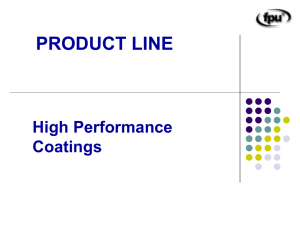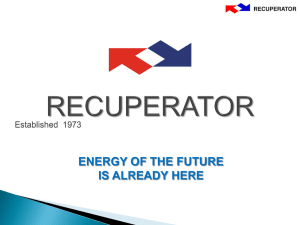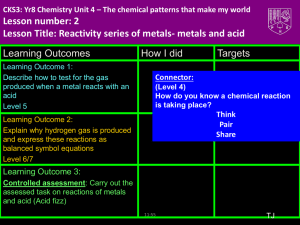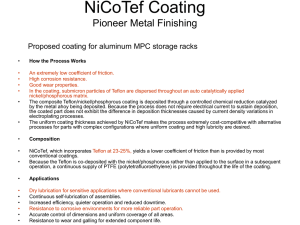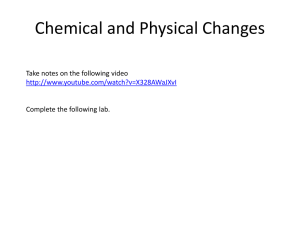Bill Gorman - Tagnite, ND
advertisement
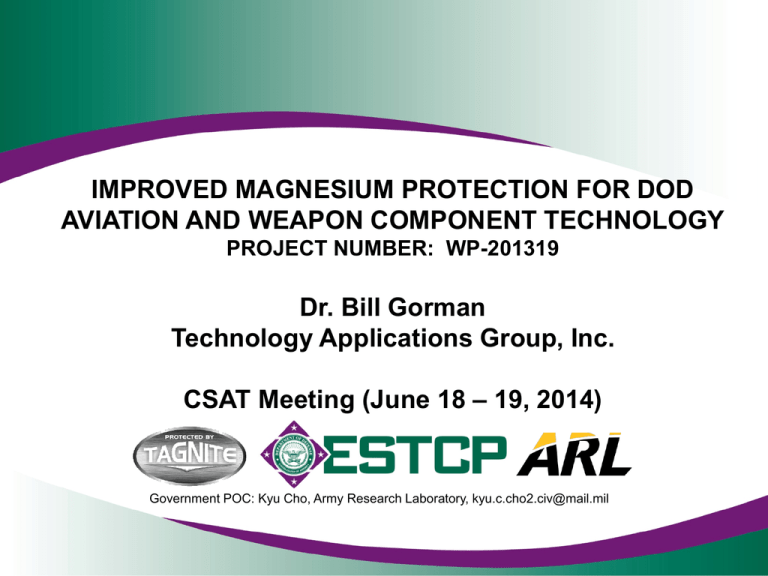
IMPROVED MAGNESIUM PROTECTION FOR DOD AVIATION AND WEAPON COMPONENT TECHNOLOGY PROJECT NUMBER: WP-201319 Dr. Bill Gorman Technology Applications Group, Inc. CSAT Meeting (June 18 – 19, 2014) Government POC: Kyu Cho, Army Research Laboratory, kyu.c.cho2.civ@mail.mil Tagnite™ Technology The Immersion Tagnite coating process consists of two steps: 1) 2) The first step (Fluoride Activator) is a simple chemical process in which the magnesium alloy is immersed into a heated solution containing the fluoride ion. The second step (Immersion Tagnite) is the deposition process. The anodization process is accomplished using a specially designed high voltage rectifier which results in the oxidation of the metal substrate and deposition of inorganic species from the silicate-containing electrolyte. As a result of the relatively high voltages, greater than 150V, a spark process develops during the deposition Tagnite Process per MIL-DTL-32459 Brush Tagnite is a hand held version of Tagnite process Applied using pad saturated with electrolyte, connected to low power rectifier Brush Tagnite electrolyte is formulated to be “friendly” around dissimilar metals Much lower deposition voltage, thinner coatings 2 Why are anodized coatings not used on repair or overhauled magnesium parts? 1. Legacy coatings (paint and magnesium pretreatment) must be totally removed prior to anodization to obtain high quality coating deposition. • Presence of old coatings will contaminate the coating bath and can result in magnesium metal loss during anodization. TAG has collaborated with several 3rd party companies to develop effective ways to remove legacy coatings 2. No dissimilar metals may contact the anodization electrolyte during the coating process. • • The magnesium anodization process is an oxidation process which leads to the formation of MgO on the surface of the part. When dissimilar metals such as steel undergo oxidation, the process converts steel into rust! Leads to pitting of the steel and contamination of the coating bath. 3 Masking of Ferrous Inserts ● In 2010, TAG was approached by AF fixed wing aircraft supplier about masking steel liners on new parts prior to Tagnite process ● Purpose of masking is to isolate dissimilar (ferrous) inserts from contact with Tagnite process solutions and water rinses ● Two possible adverse scenarios 1. 2. Flash rust of steel liners due to exposure to moisture Oxidation of steel during Tagnite anodize step which leads to pitting of metal 4 Magnesium Component with Steel Inserts AF magnesium component consists of three different castings with steel bearing liners and bushing installed prior to Tagnite anodization Bearing Liner is flush with magnesium on one side And raised above magnesium on other side. On raised side a core passage way comes directly to bearing liner. 5 Magnesium Components with Steel Inserts We Have Successfully Applied Tagnite to Over 150 Units of This Part Number. We Are Not Experimenting with Masking Ferrous Metal Inserts, We are Doing It. Machined surfaces masked off to preserve electrical conductivity. Multiple Pressed in Steel Bushing 6 Success coating AF parts motivated TAG to seek IBIF Funding to broaden scope of work ● Magnesium Corrosion is a Costly Issue Affecting All Helicopter Platforms ● Current Overhaul Coatings are Conversion Based Processes That Provide Little Corrosion Protection ● These Poor Performing Conversion Coatings Have Resulted in High Life Cycle Costs for Most Magnesium Components ● Current Overhaul Coatings Contain Hexavalent Chromium Which the DoD has Mandated for Phased Elimination ● Non-Chromate Based Anodize Coating Processes Have Heretofore Been Technically Unfeasible on Used Magnesium Components Due to Their Ferrous Metal Inserts 7 IBIF III – Project Dec. 2010 – Sept. 2012 Asked AMRDEC Engineers to pick most corrosion prone magnesium components on the H-60, H-64, and H-47 platforms 1. 2. 3. 4. 5. 6. Gearbox Housing Center Gearbox Housing Assembly Intermediate Gearbox Tail Rotor Cover Tail Rotor Gearbox Accessory Cover 8 IBIF Parts As Received from SAFR H-60 Gearbox Housing H-64 Tail Rotor GB H-64 Tail Rotor Cover 9 Removal of Old Paints and Finishes ● ● Tagnite process needs clean, bare magnesium for best results Parts were sent out to 3rd party for multi-media blasting to remove old paints and coatings 10 Center Housing – After Masking and Immersion Tagnite Hand Scripted S/N still intact 11 Accessory Cover As Received Condition After Media Clean After Tagnite TAG Proprietary Information 12 UNCLASSIFIED // Approved for public release; distribution is unlimited WP-20201319: Improved Magnesium Protection Performers: ARL, AFRL, CCAD, NAVAIR, AMCOM G-4, AMRDEC AED, AMRDEC MED, Technology Applications Group. Technology • Cleaning and masking technology that allows legacy magnesium aerospace parts containing dissimilar metals to be anodize coated with a chrome-free solution which results in same corrosion protection seen with new replacement parts. Demonstration Site/Platform: Demo at CCAD Plating Shop – Line D Demonstration Objectives • Parts in overhaul cycle are completely stripped of coatings to check for fatigue cracking. After, dipped in Cr6+ solution for a paint base but problem of minimal corrosion protection. Replace Cr6+ with Tagnite anodize without damaging inserts, liners and fasteners. Success based on compatibility with repair techniques, improved corrosion resistance and lack of damage to dissimilar metal inserts. Performance Results • Develop chemical stripping process for legacy coatings, prove Tagnite compatibility with current/future repair techniques and install/demo/validate Tagnite coating line at CCAD. Project Progress and Concerns to Date • JTP Test matrix for Tasks 1 - 3 approved Implementation Outlook • • Target Weapons Systems: AH-64, UH-60, CH-47 Must pass repair compatibility study before proceeding to CCAD Tagnite install tasks UNCLASSIFIED // Approved for public release; distribution is unlimited CCAD 13 Project Team Performers PI: Mr. Kyu Cho Army Research Laboratory Dr. Bill Gorman Technology Applications Group Dr. Elizabeth S. Berman Air Force Research Laboratory Mr. Scott Howison (no funding) Army AMCOM G-4 Mr. Jeremy Smith Mr. Jonathan Williams CCAD, Directorate of Prod. Eng. Mr. Humberto “Bert” Hernandez Jr. AMRDEC, MED Ms. Julia Russell NAS Pax River Mr. Ricky McNalley AMRDEC, AED Advisors Dr. Michael Kane AED/AMRDEC John Benfer NAVAIR Jacksonville 14 Tagnite™ Technology • ● Up to this point in time, anodizing processes such as Tagnite could not be applied to used/overhauled magnesium components done to the present of mixed metals in the castings. Ferrous metals are attacked/oxidized during the anodization process. Major Innovation: TAG has developed the methodology to isolate or “mask off” the mixed metals thereby allowing Tagnite deposition on the magnesium while maintaining the integrity of the mixed metals even to components with complex geometries! As Received After Legacy Coating Removal Masking Installed After Tagnite 15 Demonstration Site The demonstration site will be at the Corpus Christi Army Depot (CCAD) Plating Shop, Line D. Line is not currently in use. Equipment (in kind contribution) • • • • All necessary tanks & heaters Adequate ventilation Access to water and waste disposal Crane system Equipment Needed • Rectifier • Chilling System • One plastic tank liner Targeted Platforms and Components AH-64 Apache, UH-60 Blackhawk, CH-47 Chinook, Bell Commercial Aircraft • • • • • • • • Tail Rotor Cover Tail Rotor Gearbox Intermediate Gearbox Gearbox Housing Center Gearbox Covers, housings, and gearboxes Accessory Cover Combining Transmission 16 Joint Test Protocol Test metrics approved for JTP • Task 1: Compatibility with Current Repair Techniques • Task 2: Stripping of Legacy Coatings • Task 3: Brush Tagnite Qualification JTP Stakeholders • AMRDEC AED • AMRDEC MED • Army AMCOM G-4 Environmental • ARL • NAVAIR • AFRL • 160th Special Operations Aviation • Technology Application Group 17 Technical Approach & Metrics Task # Techniques or Testing Task Description a. b. 1 Tagnite compatibility with current or potential magnesium aerospace repair techniques c. d. e. 2 3 Design and validate the legacy coating stripping process Qualification of Brush Tagnite for Use on all Magnesium Aerospace Alloys Go/NoGo DEFCON Al Liquid Titanium Paste Fillers TIG Welding 6061 Al Cold Spray Repair HVOF Coatings or Alloys 1. 2. 3. 4. Immersion Tagnite Brush Tagnite DOW 19 TCP Neutral Salt Fog SO2 Salt Fog Adhesion Testing Outdoor Exposure Fatigue Studies Galvanic Corrosion a. No attack or undermining of repair area b. No loss of adhesion of repair area per ASTM D 4541 c. Acceptance of Tagnite/Brush Tagnite coating d. Galvanic Corrosion Testing per ASTM G 71 a. Ability to remove legacy coatings and leave bare metal surface b. No interference with NDT crack detection c. Effect on Dimensional Change d. Effect on Cadmium Plating e. Effect on Hydrogen Embrittlement Evaluate various types of chemical stripping a. b. c. d. e. f. Performance Metrics AZ91E EV31 QE22 ZE41 Compare performance against: a. DOW 19 b. Trivalent Chromium (TCP) c. Uncoated (Fatigue Only) BT must meet or exceed performance of DOW 19 and TCP Tagnite/Brush Tagnite coatings must pass performance metrics to justify Tagnite line installation at CCAD plating shop 18 Technical Approach & Metrics Task # Task Description 4 Design, retrofit and validate an Immersion Tagnite line at CCAD plating shop 5 6 Techniques or Testing Performers Engineering requirements to retrofit Line D at CCAD plating shop AMRDEC TAG Contractors Generate priority list of magnesium components from legacy platforms for Immersion/Brush Tagnite treatment Input from DoD engineers, materials experts and maintenance personnel AMRDEC AED NAVAIR AFRL TAG Develop, test and validate masking designs for High Priority Legacy Components a. Successful design of masking tools b. Successful coating of scrap parts c. Successful coating of overhaul parts AMRDEC AED NAVAIR AFRL TAG Performance Metrics a. Retrofit tanks to handle Tagnite requirements b. Install and validate chilling systems c. Install and validate rectifier Prioritize needs based on: a. corrosion problems b. critical need c. System capacity d. parts to test limits of masking capabilities Ability to apply Immersion Tagnite without damage to mixed metals a. Visual Inspection b. Optical Inspection c. Engineering evaluation d. Airworthiness acceptance 19 Technical Approach & Metrics Task # Techniques or Testing Task Description a. 7 Development of masking and/or Brush Tagnite techniques that decrease BT application time b. c. 8 9 Demonstration of the Immersion Tagnite line at CCAD plating shop with masked, used magnesium components Reporting (Assume project starts March 2013) Investigate smaller o-rings used in masking Design custom brush heads to speed up coating process Testing on scrap components On-site training of CCAD personnel for: a. Immersion Tagnite b. Brush Tagnite c. Masking Protocols Actual application: a. Scrap parts b. Overhauled parts Performers Performance Metrics ARMDEC TAG a. Document time needed to Brush Tagnite individual components using conventional Brush Tagnite b. Document time with modified Brush Tagnite components on same magnesium component c. Calculate time reduction AMRDEC AED TAG AMRDEC AED NAVAIR AFRL ARL TAG a. Successful application of masking tools per TAG requirements b. Successful application of Immersion Tagnite and Brush Tagnite to scrap and overhaul parts Go/NoGo: September 2014 Start Demonstration at CCAD: March 2015 Draft Final Report: Jan 2016 Final Report: March 2016 20 Major Milestone Schedule ● The primary Go/NoGo decision occurs after the data analysis of the Tagnite™ compatibility study with current and proposed repair techniques. Upon demonstration of the Tagnite™ compatibility with repair and stripping techniques, the immersion Tagnite™ installation tasks are fully engaged. The expected Go/NoGo decision is NLT Q4 FY14. ● Immersion Tagnite™ Demonstration/Validation process is expected to start at the beginning of 1Q FY16. Design of immersion Tagnite™ work can start as soon as the compatibility study is being completed in 3Q FY14 to set aside for design, modification and installation of equipment. The retrofit of D-line at the CCAD plating shop should involve little modification to the line. Critical installation items would be the chilling system and rectifier. 21 Technology Endorsement by Acquisition Community ● “……. UHPO has identified cold spray repair and Tagnite anodizing as viable and demonstrated technologies to improve the environmental sustainability of repair and overhaul practices involving magnesium transmission housings used in Army Aviation systems…….” by Utility Helicopter Project Office ● Similar endorsements are being made with other helicopter PMOs 22 Tagnite/Cold Spray Compatibility Study (MidAmerica/TAG Joint Project) ● ● ● ● Is the Tagnite pre-treatment solutions compatible with 6061 and Aluminum/Aluminum Oxide Cold Spray? How adherent is the Tagnite coating when applied over 6061 and Aluminum/Aluminum Oxide Cold Spray? How adherent is the Rockhard Sealant when applied over 6061 or Aluminum/Aluminum Oxide Cold Spray coated with Tagnite? What kind of Tagnite layer forms over 6061 and Aluminum/Aluminum Oxide Cold Spray? 23 Acknowledgement Research was sponsored by the Army Research Laboratory and was accomplished under Cooperative Agreement Number W911NF-13-2-0019. The views and conclusions contained in this document are those of the authors and should not be interpreted as representing the official policies, either expressed or implied, of the Army Research Laboratory or the U.S. Government. The U.S. Government is authorized to reproduce and distribute reprints for Government purposes notwithstanding any copyright notation herein. Bill Gorman, Director of R & D bgorman@tagnite.com 1-800-TAGNITE 701-746-1818 Bill Elmquist, President belmquist@tagnite.com 1-800-TAGNITE 701-746-1818 24


